 Introduction |
Equipment |
Denmark |
Route |
Expedition |
About us
Introduction |
Equipment |
Denmark |
Route |
Expedition |
About us
The diary
Day 1: 21 August, 90 km
Swinoujscie - Griebienow
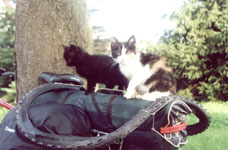
The great expedition started in Swinoujscie where, very fresh, we got off the train after all night lost in the trains' corridor with our equipment. Nevertheless our optimism wasn't cooled down even by the little shower that after some time turned out to be quite a serious rain. It accompanied us till the late evening. We bought the last necessary things in Swinoujscie and went in the frontier's direction. In the company of Germans coming back from their morning shopping we crossed the border and, full of optimism, we went on to discover the unknown. To have some orientation we stopped after some 25 km to find a tourist information office where we got the schematic map of the region. We even found the bike road that took us alongside the coast. However we were forced to leave it after getting to the same place for a couple of times. The first day finished with the absolute success - finding a fantastic shelter in a milk farm in the village of Griebenow.
Day 2: 22 August, 119 km
Griebienow - Rostock - (ferry) - Gedser
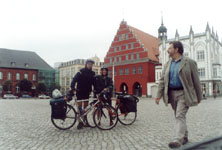
The second day wasn't very different from the first one. It was raining slightly less but it was raining anyway. Being sure that the ferries from Rostock to Denmark circulate day and night we decided not to worry about the hour of our arrival to the port and spend some time sightseeing in Rostock. We reached it at 19:30 and fortunately asked a local sportsman for the way. He felt our situation very well and decided to see us off to the port. His help was invaluable and here we would like to thank him once more. The problem was that the way to the port led either by a motorway, which we didn't really like to take, or by the off-roads known only to the local sportsmen. We were really lucky - we got to the port at 20:56 and the ferry left at 21:00. The terrible service, light-fast embarkation and ... the consciousness of a good deal. The ferry to Denmark cost us 10 DEM each with a bike! 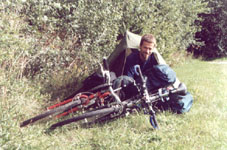 2 hours of absolute relax onboard with chips and chocolate bananas let us set up a plan of action after disembarkation. Disembarkation but still on an island, we were not supposed to touch the real land for many days still, Denmark consists of more than 400 islands. Slightly after 23:00 we got to Gedser, the little town in the south of the Falster Island. We found an amazing shelter quite close to the people settlements, as we found out in the morning, right in front of a school building!
2 hours of absolute relax onboard with chips and chocolate bananas let us set up a plan of action after disembarkation. Disembarkation but still on an island, we were not supposed to touch the real land for many days still, Denmark consists of more than 400 islands. Slightly after 23:00 we got to Gedser, the little town in the south of the Falster Island. We found an amazing shelter quite close to the people settlements, as we found out in the morning, right in front of a school building!
Day 3: 23 August, 78 km
Gedser - Nykobing F - (ferry) - Udby
In the morning, not too early, we set out in the north direction. Timidly we thought how nice it would be to get as far north as the Skagen peninsula, the Denmark's most northern point. These were far seeing plans and for the time being we concentrated on contemplating the surroundings. And the surroundings were really beautiful. Fields of windmills and, what was the most important, bike roads. Roads so fantastic that it was difficult to believe that they were really created for us, bikers. 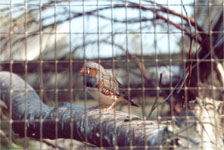 The friendly women in the tourist information office in Gedser gave us, in spite of our protest, plenty of brochures and maps which we found very useful on the way and some of which we still keep as valuable souvenirs. We arrived to the first bigger Danish town, Nykobing, sometimes called also Nykobing F. What's good to see there is the little zoo (entrance free) and the medieval city centre. From Nykobing we went north east in the direction of the Mon Island, that we had a pleasure to visit next day.
The friendly women in the tourist information office in Gedser gave us, in spite of our protest, plenty of brochures and maps which we found very useful on the way and some of which we still keep as valuable souvenirs. We arrived to the first bigger Danish town, Nykobing, sometimes called also Nykobing F. What's good to see there is the little zoo (entrance free) and the medieval city centre. From Nykobing we went north east in the direction of the Mon Island, that we had a pleasure to visit next day.
Day 4: 24 August, 63 km
Udby - Mons Klint - Udby - Kalvehave
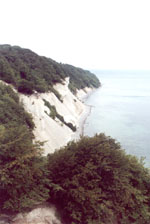
The Island's main attraction are the cliffs on its east coast. Sometimes they are nearly 150 m high and are really spectacular. We found another attraction in the form of a beautiful palace surrounded by some cottages brought from varions sites in Scandinavia. The weather was 'quite' unfriendly, especially during our return. It was not only raining cats and dogs but we also had an opportunity to get to know the Danish winds better. From then the winds were supposed not to leave us till the end of the expedition. Denmark, in spite of the dominating point of view, is not at all a flat country. And that's the result of the glaciers that visited this country quite frequently in the previous periods. This causes that one feels there as in the low but very dense mountains. It sounds easy, a little up the hill, but then comes the 'downhill' part. Sounds easy, but not in Denmark. There it's not easy even to go down. We found that out for the first time while cycling from Mon to the main Danish island - Sjaelland. The 10-15 km/h descents were possible only with our great effort, in other case the wind blew us back up the hill. Thanks to an immense effort we managed to reach Sjealland that night.
Day 5: 25 August, 104 km
Kalvehave - Fakse - Koge - Copenhagen suburbs
Having spent the night in the forest, being like most of the Danish rare forests, a protected area, we started the fifth day of the expedition. It was during that day that we discovered probably the only inconvenience of the Danish bike roads. The distances between different points tend to get longer when one follows those roads. 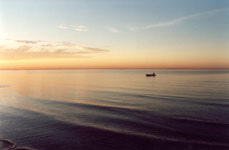 Although much quieter and calmer than normal car roads, they often follow slightly around. As a matter of fact the bike roads are quite frequently normal car roads that aren't used by cars any more or aren't used by cars too often. This day we got to the Copenhagen suburbs and we decided to spend the night in a very romantic way - in the moonlight on a beach. It turned out, unfortunately much later, that it was one of our worst ideas. Even though there was nearly no wind, the temperature fell to 4░C, and the humidity was unbearable. It was impossible to sleep for more than 15 minutes without waking up just to check whether it was not already early enough to get up.
Although much quieter and calmer than normal car roads, they often follow slightly around. As a matter of fact the bike roads are quite frequently normal car roads that aren't used by cars any more or aren't used by cars too often. This day we got to the Copenhagen suburbs and we decided to spend the night in a very romantic way - in the moonlight on a beach. It turned out, unfortunately much later, that it was one of our worst ideas. Even though there was nearly no wind, the temperature fell to 4░C, and the humidity was unbearable. It was impossible to sleep for more than 15 minutes without waking up just to check whether it was not already early enough to get up.
Day 6: 26 August, 76 km
Copenhagen - Faro
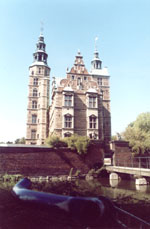
After those experiences we were prized by the extremely spectacular sunrise above Copenhagen which we reached shortly. The capital's sightseeing took several hours. We saw most of the monuments suggested by our guide including the vegetarian restaurant run by the Krishna brothers. There we ate our first warm meal. The first and the last one, as it turned out later. 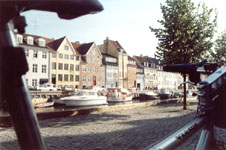 One of the most interesting sites was the Free City Christiania inhabited by those who oppose against any form of administration. Leaving Copenhagen we found out another fascinating aspect of the Danish bike roads. Sometimes they are set just by the side of motorways. Obviously, just like on the motorway, all the crossroads are no-collision .
One of the most interesting sites was the Free City Christiania inhabited by those who oppose against any form of administration. Leaving Copenhagen we found out another fascinating aspect of the Danish bike roads. Sometimes they are set just by the side of motorways. Obviously, just like on the motorway, all the crossroads are no-collision .
Day 7: 27 August, 133 km
Frederiksvaerk - Hundested - (ferry) - Overby - (ferry) - Arhus - Lystrup
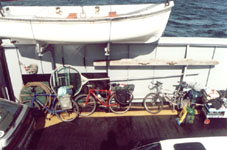
The seventh day was a real day of the race. We lost the first round but got a better score on the second. We took part in the races whenever we were supposed to take a ferry and we knew it's departure time. By the way, it's really worth to know the departure times. Normally the ferries run regularly, however sometimes there are important exceptions. 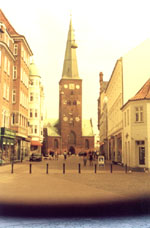 What's more, sometimes it may turn out that there is only one ferry a day, however this is rather the wintertime case. The first round we finished getting to the port just when the ferry was closing. The other we won with 5 minutes in reserve. The second ferry was really impressive - it was a giant catamaran that crossed the sea from Havnebyen to the second biggest city in Denmark - Arhus in an hour going up to 85 km/h. Had we gone with the same speed all the time, we would not have had to travel for 3 weeks but for 3 days only! On that sunny Sunday afternoon Arhus turned out to be absolutely deserted. Happy to touch the continent again, we set out.
What's more, sometimes it may turn out that there is only one ferry a day, however this is rather the wintertime case. The first round we finished getting to the port just when the ferry was closing. The other we won with 5 minutes in reserve. The second ferry was really impressive - it was a giant catamaran that crossed the sea from Havnebyen to the second biggest city in Denmark - Arhus in an hour going up to 85 km/h. Had we gone with the same speed all the time, we would not have had to travel for 3 weeks but for 3 days only! On that sunny Sunday afternoon Arhus turned out to be absolutely deserted. Happy to touch the continent again, we set out.
Day 8: 28 August, 114 km
Lystrup - Randers - Hadsund - Alborg
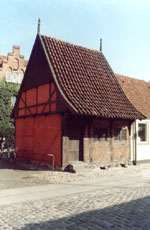
The legendary goal, Skagen, seemed more and more realistic. We had no more than two day road that separated us from it. The North of Denmark turned out to be very different from what we had seen before. The pastures replaced fields, settlements became rarer and already rare forest disappeared completely. 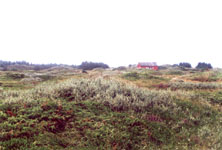 The very characteristic view in the North of Denmark are the vast heathers, often situated on the sand-dunes. We crossed the industrial cities of Randers and Aalborg and decided that every Danish town and city was interesting in a way. As a matter of fact it's true not only for Denmark. But there every industrial city has it's medieval centre where one can see the historic monuments.
The very characteristic view in the North of Denmark are the vast heathers, often situated on the sand-dunes. We crossed the industrial cities of Randers and Aalborg and decided that every Danish town and city was interesting in a way. As a matter of fact it's true not only for Denmark. But there every industrial city has it's medieval centre where one can see the historic monuments.
Day 9: 29 August, 115 km
Orum - Sindal - Albaek - Skagen - Grenen - Skagen
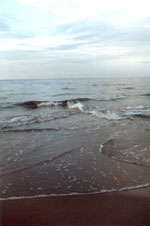
We reached our goal on the ninth day late in the afternoon. We arrived to Skagen. Obviously we had to celebrate that. The main attraction of the celebration party took the form of dried strawberries! What was our disappointment when we found out that our dried strawberries were not at all dry but, in contrary, very wet. 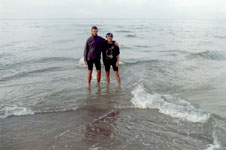 They turned out to be a strawberry jelly! We didn't learn Danish till the last day of the trip. Anyway, the place where the Baltic and the North Seas' waters meet proved to be worth of being the expedition's goal. From the moment when we left it, our getting back started. However firstly in quite an opposite direction.
They turned out to be a strawberry jelly! We didn't learn Danish till the last day of the trip. Anyway, the place where the Baltic and the North Seas' waters meet proved to be worth of being the expedition's goal. From the moment when we left it, our getting back started. However firstly in quite an opposite direction.
Day 10: 30 August, 138 km
Skagen - Tversted - Horring - Aabybro
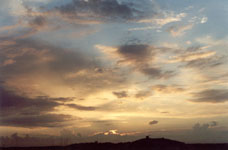
On the tenth, jubilee day the return started for serious. Like a real return, ours was also accompanied by a heavy rain. This wasn't really different from the previous days. Since we found sunbathing impossible in Denmark, we were forced to bath in the rain. And although we were getting farther and farther from Poland we actually felt we were approaching. We just wanted to say 'good-bye' to the North Sea and for that reason had to go to the west coast of Denmark.
Day 11: 31 August, 162 km
Tranum - Oster - Torup Strand - Bulbierg - Thisted - Agger - (ferry) - Thyboron - Harboore - Lemvig

The final farewell took place on the eleventh day of the expedition. We first said 'goodbye' to the sea from the cliffs' level (those cliffs are inhabited by some 500 pairs of kittywakes). And then, finally, late in the afternoon we crossed the last tiny bit of the sea by a ferry. To which we got in a race, certainly (the lost one, unfortunately). After disembarkation we found ourselves in a different world. In a little, lost American town, Thyboron. Quite stunned we decided to get a closer look at it and we left only after we had found out that everything was OK, and that we still were in Denmark. The day turned out to be really exhausting. Not only we cycled for over 160 km and found a shelter 2 hours after the sunset, but sometime after it got dark one of our Tranz-x racks crashed. Later on it crashed again, but to find our opinion on it we ask you to go to the Equipment page.
Day 12: 1 September, 125 km
Lemvig - Holstebro - Havnstrup - Arnborg - Brande - Give
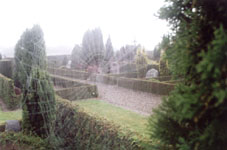
On the twelfth day we passed by Legoland. The discussion on whether to visit this best known Danish tourist attraction or not, lasted from the beginning of the expedition. Finally we passed by and actually we passed as far as possible from this site. Why? Try to imagine two old farts riding Lego bricks trains among Lego bricks buildings, castles, towns and even Indians. Instead of riding bikes. Now we hope, you have answered, why. Besides we were gaining speed in our way home.
Day 13: 2 September, 118 km
Vejle - Fredericia - Harndrup - Skalbierg near to Odense
The next day a very surprising thing happened - we met a group of Polish sports' fans who came there to watch the motor races. It's not that the Poles don't travel a lot. It's not even that we avoided our nationals. The problem is that they don't visit Denmark too often which is even more surprising taking into consideration the proximity of these two countries. 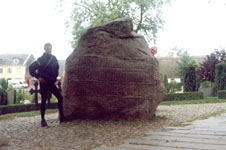 The same day we got to the islands again. This time we landed at Fyn, the island called the 'Danish Garden'. We found this name confusing since, in spite of what had been written in our guide, there aren't more gardens there than in other regions of southern Denmark. Maybe there are even less. On the Fyn Island there is the third biggest Danish city, Odense. It was there where Hans Christian Andersen was born, and where two museums on his subject were created. However during his life he was not a respected citizen there. Because of that we decided not to support by our visit those who live off the writer's fame and we passed by.
The same day we got to the islands again. This time we landed at Fyn, the island called the 'Danish Garden'. We found this name confusing since, in spite of what had been written in our guide, there aren't more gardens there than in other regions of southern Denmark. Maybe there are even less. On the Fyn Island there is the third biggest Danish city, Odense. It was there where Hans Christian Andersen was born, and where two museums on his subject were created. However during his life he was not a respected citizen there. Because of that we decided not to support by our visit those who live off the writer's fame and we passed by.
Day 14: 3 September, 178 km
Skalbierg - Brobyvaerk - Svendborg - Spodsbjerg - (ferry) - Nakskov - Maribo - Nykobing F - Gedser
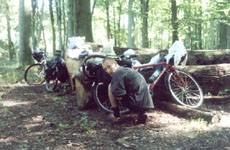
Our journey sped up. For the firs time in the expeditions story we got a side wind (and not just in the face). Passing by the islands we came across an extraordinary phenomenon. It was a giant bridge that arose right of a sudden, just from the sea. It surprised us a lot but finally we managed to cross it. Later we had another ferry ride, several bridges, and the bike road on the Lolland Island. As a matter of fact the road didn't cross the island but went here and there as if just to show us all the most beautiful (or simply all) sites there. Late in the afternoon we got to Nykobing, called sometimes Nykobing F. (just to explain, the other part of the name results from the fact that it's not the only Nykobing in Denmark, however it's the only one on the Falster Island). This way we closed the loop. The only thing we had to do was to get to Gedser and take the ferry to Rostock the following morning.
Day 15: 4 September, 154 km
Gedser - (ferry) - Rostock - Sarnow
The last night in Denmark we spent in the same place as the first one. This time however the children playing didn't wake us up in the morning. First of all, because we got up slightly after 3 a.m.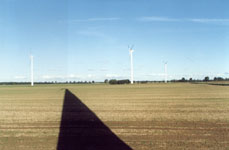 Having finished sleeping on a ferry, we found ourselves in Germany just after six. The way from the port was already well known to us and so we found it without any problem. However we were brutally woken from the beautiful Danish dream. In Germany a biker cannot expect to have the priority nor even to be culturally overtaken. At first it was a shock but soon we got used to it. The first relaxing shopping made us discover in what a cheap country we were. That made us happier. We continued our way home.
Having finished sleeping on a ferry, we found ourselves in Germany just after six. The way from the port was already well known to us and so we found it without any problem. However we were brutally woken from the beautiful Danish dream. In Germany a biker cannot expect to have the priority nor even to be culturally overtaken. At first it was a shock but soon we got used to it. The first relaxing shopping made us discover in what a cheap country we were. That made us happier. We continued our way home.
Day 16: 5 September, 113 km
Sarnow - Altwarp - (ferry) - Nowe Warpno - Szczecin
The sixteenth day in the morning, just like the fifteenth day in the evening, we only had some 50-60 km to the frontier. We got to Altwarp on the Szczecin Lake. There are ferries that cross the Lake to go to Nowe Warpno and Swinoujscie in Poland. Both ferries have duty-free shops on-board and those shops constitute the main tourist 'attraction' in the region. It turned out that the passengers who got off the ferry with us in Nowe Warpno were really rare. The majority preferred to stay on-board benefiting from the beautiful weather and queuing while the shop was closed. POLSKA. Poland welcomed us with the beautiful Wkrzanska Forest, 50 km to Szczecnin, nearly all the time through the forest. The expedition was about to finish. We visited friends, consumed Polish cakes... A day or two after, in the trains to Lodz and Cracow, for the first time we could calmly think of what we had done. We could firmly say the expedition had been a great success.
Introduction |
Equipment |
Denmark |
Route |
Expedition |
About us
 2 hours of absolute relax onboard with chips and chocolate bananas let us set up a plan of action after disembarkation. Disembarkation but still on an island, we were not supposed to touch the real land for many days still, Denmark consists of more than 400 islands. Slightly after 23:00 we got to Gedser, the little town in the south of the Falster Island. We found an amazing shelter quite close to the people settlements, as we found out in the morning, right in front of a school building!
2 hours of absolute relax onboard with chips and chocolate bananas let us set up a plan of action after disembarkation. Disembarkation but still on an island, we were not supposed to touch the real land for many days still, Denmark consists of more than 400 islands. Slightly after 23:00 we got to Gedser, the little town in the south of the Falster Island. We found an amazing shelter quite close to the people settlements, as we found out in the morning, right in front of a school building!


















